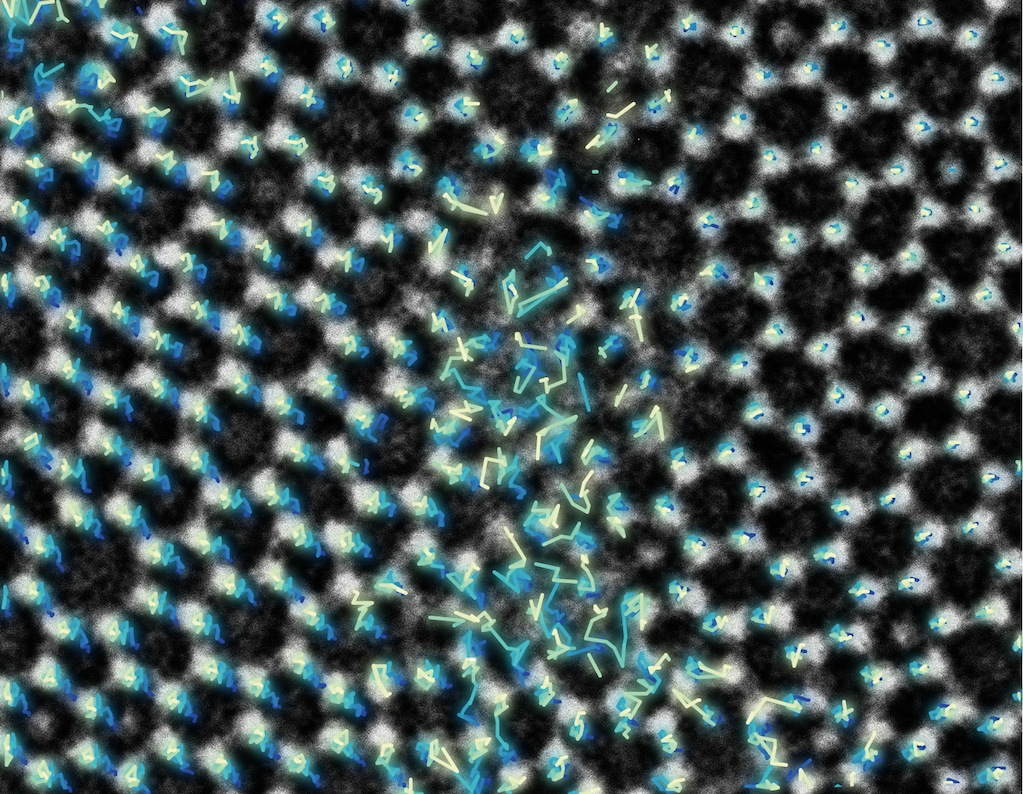
Scientists have captured the wiggle of tiny molecules of the world's thinnest glass as they undergo strain.
The new images, described today (Oct. 10) in the journal Science, show that in small, localized regions, glass behaves like a crystal, with atoms aligned in an orderly matrix. But at long-length scales, its disorder dictates its flexibility. The new insights could help scientists understand how glass bends and breaks.
Humans have been using glass for thousands of years. Stone Age hunters used obsidian, a naturally occurring volcanic glass in cutting tools, and glass beads appeared in Mesopotamia more than 5,000 years ago. [In Photos: Treasures of Mesopatamia]
Yet despite so many centuries of use, scientists understand relatively little about how glass bends, breaks and moves at the atomic level. Glass is an amorphous solid, without a specific crystal structure, and it can be difficult to capture the motion of individual atoms in action.
To do so, the team shined a beam of electrons on the world's thinnest film of glass, nudging the molecules to move around. The microscope also captured the molecular rearrangements in real-time video.
The researchers also revealed the transition between glass's liquid phase and its amorphous or crystalline state as the material was placed under shear strain.
Study researcher David A. Muller, a professor of applied and engineering physics at Cornell University, told LiveScience that the most fascinating part of watching the glass melt and resolidify was seeing the atoms come back together in patterns different from their original arrangement.
Sign up for the Live Science daily newsletter now
Get the world’s most fascinating discoveries delivered straight to your inbox.
"The glass had no memory of its previous structure," Muller wrote in an email. "This is in some sense, at the heart of what it means to be a glass, but it is still surprising to see it occurring on such a local scale."
While making a sheet of graphene, Muller and colleagues inadvertently created a residue of 2D glass, which has been recognized as the all-time thinnest in the in the 2014 edition of the Guinness Book of World Records. The researchers used samples from this batch of super-thin glass in their new study. But if the team can pin down a reproducible recipe to make this material for use in nanotechnology, Muller said it would be very patentable.
The advance may also have implications beyond glass, to other materials without defined, orderly structures. With the new imaging technique, researchers could also study how adding different materials into the glass could alter its structural properties, wrote Markus Heyde, a materials scientist at the Franz Haber Institute of of the Max Planck Society in Germany, wrote in an accompanying perspectives article in Science.
"The opening and closing of ring structures and the subsequent rearrangements can be directly observed. The results open new ground for modeling the atomic structure and dynamics in glass," wrote Heyde, who was not involved in the study.
Editor's note: This article was updated on Oct. 11.
Follow Tia Ghose on Twitter and Google+. Follow LiveScience @livescience, Facebook & Google+. Original article on LiveScience. LiveScience writer Megan Gannon contributed to this article.

Tia is the managing editor and was previously a senior writer for Live Science. Her work has appeared in Scientific American, Wired.com and other outlets. She holds a master's degree in bioengineering from the University of Washington, a graduate certificate in science writing from UC Santa Cruz and a bachelor's degree in mechanical engineering from the University of Texas at Austin. Tia was part of a team at the Milwaukee Journal Sentinel that published the Empty Cradles series on preterm births, which won multiple awards, including the 2012 Casey Medal for Meritorious Journalism.









